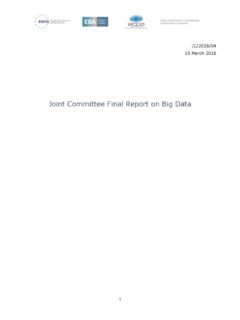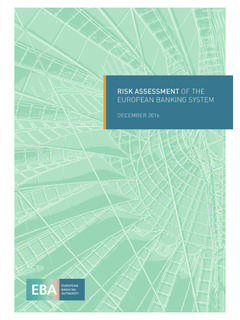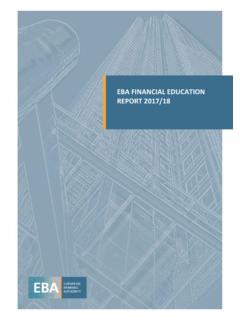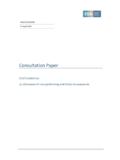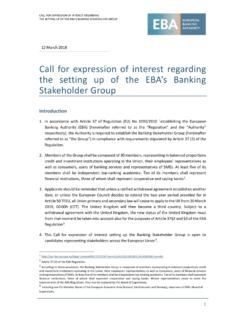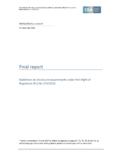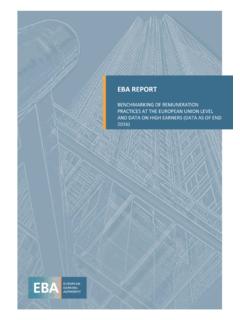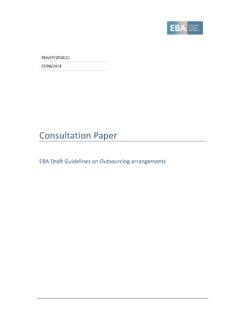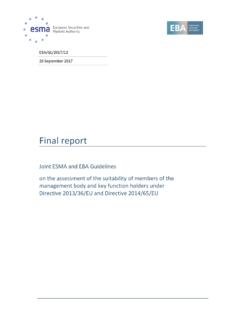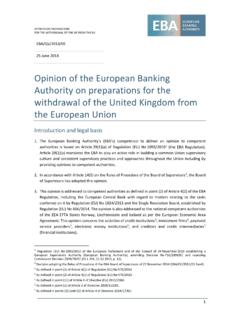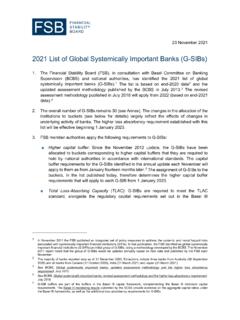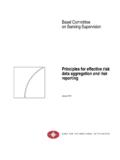Transcription of Report
1 EBA/GL/2021/09 15 September 2021 Report Final Guidelines specifying the criteria to assess the exceptional cases when institutions exceed the large exposure limits of Article 395(1) of Regulation (EU) No 575/2013 and the time and measures to return to compliance pursuant to Article 396(3) of Regulation (EU) No 575/2013 GUIDELINES SPECIFYING THE CRITERIA TO ASSESS THE EXCEPTIONAL CASES WHEN INSTITUTIONS EXCEED THE LARGE EXPOSURE LIMITS OF ARTICLE 395(1) OF REGULATION (EU) NO 575/2013 AND THE TIME AND MEASURES TO RETURN TO COMPLIANCE PURSUANT TO ARTICLE 396(3) OF REGULATION (EU) NO 575/2013 2 Contents 1. Executive Summary 3 2. Background and rationale 4 3. Guidelines 11 4. Accompanying documents 21 GUIDELINES SPECIFYING THE CRITERIA TO ASSESS THE EXCEPTIONAL CASES WHEN INSTITUTIONS EXCEED THE LARGE EXPOSURE LIMITS OF ARTICLE 395(1) OF REGULATION (EU) NO 575/2013 AND THE TIME AND MEASURES TO RETURN TO COMPLIANCE PURSUANT TO ARTICLE 396(3) OF REGULATION (EU) NO 575/2013 3 1.
2 Executive Summary In general, the large exposures framework acts as a backstop, safeguarding an institution from significant losses caused by the sudden default of a client or a group of connected clients due to the occurrence of an unforeseen event which could endanger the institution s solvency. If in an exceptional case an institution breaches the limits set out in Article 395(1) of the Capital Requirements Ratio (CRR), the first subparagraph of Article 396(1) of the CRR requires the value of the exposure to be reported without delay to the competent authority, which may (where the circumstances warrant it) allow the institution a limited period of time in which to restore compliance with the limit. Article 396(3) of the CRR2 mandates the EBA to issue guidelines, in accordance with Article 16 of Regulation (EU) No 1093/2010,1 to specify how competent authorities may determine: (a) the exceptional cases referred to in paragraph 1 of Article 396 of the CRR; (b) the time considered appropriate for returning to compliance; and (c) the measures to be taken to ensure the timely return to compliance of the institution.
3 The guidelines contain four sections: i) criteria to determine the exceptional cases referred to in Article 396(1) of the CRR; ii) information to be provided to the competent authority in case of a breach of the Large Exposure limits; iii) criteria to determine the appropriate time to return to compliance with the limits of Article 395(1) of the CRR; and iv) measures to be taken to ensure the timely return to compliance of the institution with the limits of Article 395(1) of the CRR. Current practices by competent authorities have constituted the starting point for the development of these guidelines. The guidelines have been developed with the following objectives: (i) provide guidance to competent authorities in their assessment of the breaches of the large exposure limits set out in Article 395(1) of the CRR; (ii) ensure a prudent and harmonised application of Article 396(3) of the CRR, while keeping the approach simple; and (iii) ensure a level playing field among institutions in the Union.
4 These guidelines provide guidance from a going-concern perspective. Gone-concern situations in which an institution is in the process of restructuring or undergoes a similar crisis-induced scenario are consequently outside the scope of these guidelines. In such situations, measures are needed that go well beyond restoring compliance with the large exposures framework of the CRR. Next steps The guidelines will be translated into the official EU languages and published on the EBA website. The deadline for competent authorities to Report whether they comply with the guidelines will be 2 months after the publication of the translations. The guidelines will apply from 1 Regulation (EU) No 1093/2010 of the European Parliament and of the Council of 24 November 2010 establishing a European Supervisory Authority (European Banking Authority), amending Decision No 716/2009/EC and repealing Commission Decision 2009/78/EC.
5 OJ L 331, , p. 12 47. GUIDELINES SPECIFYING THE CRITERIA TO ASSESS THE EXCEPTIONAL CASES WHEN INSTITUTIONS EXCEED THE LARGE EXPOSURE LIMITS OF ARTICLE 395(1) OF REGULATION (EU) NO 575/2013 AND THE TIME AND MEASURES TO RETURN TO COMPLIANCE PURSUANT TO ARTICLE 396(3) OF REGULATION (EU) NO 575/2013 4 2. Background and rationale General considerations on breaches of the large exposure limits of Article 395(1) of Regulation (EU) No 575/2013 Background 1. In October 2016 the EBA issued an opinion in response to the European Commission s call for advice, where it set out its views on the review of the European large exposures In that opinion, the EBA called on the EU institutions to introduce some amendments with a view to (a) aligning Regulation (EU) No 575/2013 (the Capital Requirements Regulation, hereinafter the CRR)3 with the Basel standard on large exposures (LEX30);4 (b) removing some exemptions; and (c) improving some technical details.
6 2. As part of the Risk Reduction Measures (RRM) package adopted by EU legislators in May 2019, the CRR was The amended CRR reflected some of the elements of the EBA s opinion. For instance, the capital basis on which large exposure limits are calculated was restricted to Tier 1 capital, and a tighter limit of 15% of Tier 1 capital on exposures between global systemically important institutions (G-SIIs) was In addition, a mandate was inserted for EBA Guidelines to specify the key aspects of the treatment of breaches of the large exposure limits, as recommended in the aforementioned opinion. 3. In general, the large exposures framework acts as a backstop, safeguarding an institution from significant losses caused by the sudden default of a client or a group of connected clients due to the occurrence of an unforeseen event which could endanger the institution s solvency. Legal mandate 4.
7 Article 395(1) of the CRR defines the large exposure limits to a client or a group of connected clients, after taking into account the effect of credit risk mitigation in accordance with Articles 399 to 403 of the CRR, as 25% of the institution s Tier 1 capital (or 15% between G-SIIs). Furthermore, if the client is an institution or the group of connected clients includes one or more institutions, the limit shall be either 25% of the institution s Tier 1 capital or EUR 150 million, whichever is higher. According to Article 395(3) of the CRR, institutions shall comply with these large exposure limits at all times. 2 The EBA s response to the European Commission s call for advice, EBA-OP-2016-17 of 24 October 2016. 3 Regulation (EU) No 575/2013 of the European Parliament and of the Council, of 26 June 2013, on prudential requirements for credit institutions and investment firms and amending Regulation (EU) No 648/2012.
8 4 LEX Large exposures LEX30 Exposure measurement. 5 Regulation (EU) No 2019/876 of the European Parliament and of the Council of 20 May 2019 amending Regulation (EU) No 575/2013 as regards the leverage ratio, the net stable funding ratio, requirements for own funds and eligible liabilities, counterparty credit risk, market risk, exposures to central counterparties, exposures to collective investment undertakings, large exposures, reporting and disclosure requirements, and Regulation (EU) No 648/2012. OJ L 150, , p. 1 225. 6 These changes will enter into force as of 28 June 2021. GUIDELINES SPECIFYING THE CRITERIA TO ASSESS THE EXCEPTIONAL CASES WHEN INSTITUTIONS EXCEED THE LARGE EXPOSURE LIMITS OF ARTICLE 395(1) OF REGULATION (EU) NO 575/2013 AND THE TIME AND MEASURES TO RETURN TO COMPLIANCE PURSUANT TO ARTICLE 396(3) OF REGULATION (EU) NO 575/2013 5 5. According to Article 393 of the CRR, institutions shall have sound administrative and accounting procedures and adequate internal control mechanisms for the purposes of identifying, managing, monitoring, reporting and recording all large exposures and any subsequent changes to them, in accordance with the CRR.
9 6. If, in an exceptional case, an institution breaches the limits set out in Article 395(1) of the CRR (hereinafter, the large exposure limits), the first subparagraph of Article 396(1) of the CRR requires the institution to Report the value of the exposure without delay to the competent authority, which may, where the circumstances warrant it, allow the institution a limited period of time in which to comply with the limits. 7 7. Regulation (EU) No 2019/876 amending the CRR, published in the Official Journal (OJ) of the EU on 7 June 2019 (hereinafter, the CRR2), includes several mandates relating to the calculation and limitation of large exposures. Among them, a new third subparagraph was added in Article 396(1) of the CRR, stating that where, in the exceptional cases referred to in the first and second subparagraph of this paragraph, a competent authority allows an institution to exceed the limit set out in Article 395(1) for a period longer than 3 months, the institution shall present a plan for a timely return to compliance with that limit to the satisfaction of the competent authority and shall carry out that plan within the period agreed with the competent authority.
10 The competent authority shall monitor the implementation of the plan and shall require a more rapid return to compliance if appropriate . 8. Article 396(3) of the CRR2 mandates the EBA to issue guidelines, in accordance with Article 16 of Regulation (EU) No 1093/2010,8 to specify how competent authorities may determine: a) the exceptional cases referred to in paragraph 1 of Article 396 of the CRR; b) the time considered appropriate for returning to compliance; and c) the measures to be taken to ensure the timely return to compliance of the institution. 9. These guidelines give effect to that mandate. Although the CRR does not establish a deadline to publish the guidelines, the EBA roadmap on the Risk Reduction Measures (RRM) package of November 2019 foresees their publication by 31 December 10. The cases set out in Article 395(5) of the CRR, large exposure breaches stemming exclusively from exposures on the institution s trading book, fall outside the scope of these guidelines as long as the conditions laid down in that provision are fully met.
